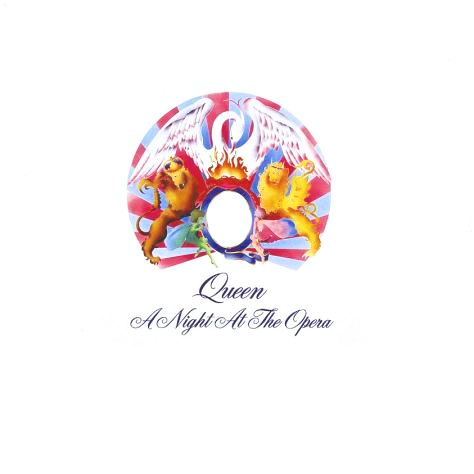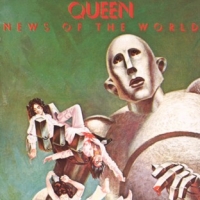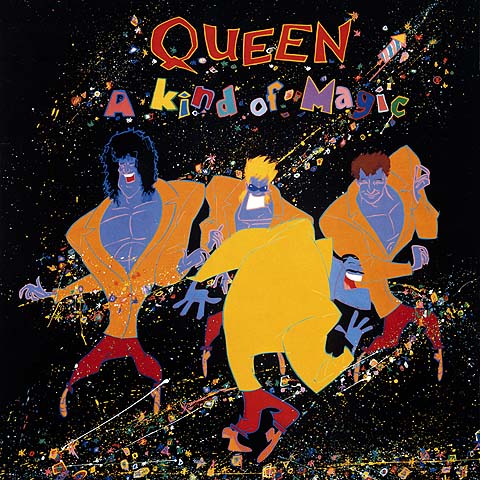XX-XX-1975 – A Night at the Opera – Melody Maker
Queen was well-known at the time of this album’s debut for hard rock. The band’s third release, Sheer Heart Attack, had proved that they could push the limits of the genre and gain international success. But I doubt that many believed that Queen could blow those limits away so completely as they do in A Night At The Opera. The music ranges from pop (“You’re My Best Friend”) to heavy metal (“Death On Two Legs,” etc.) to ballad to sprightly singalong to multi-layered instrumental (“God Save The Queen,” would you believe), and the lyrics go everywhere from fantasy (“Prophet Song”) and sci-fi (“’39” is one of only two songs I can think of that deals with the effects of time dilation during near-light-speed travel) to heartbreak. There are campy seaside songs (“Lazing On A Sunday Afternoon,” “Seaside Rendezvous,” “Good Company”) placed schizophrenically (sometimes without a pause) up against earnest hard rock numbers – and then there are tracks that combine many of these elements, like “Bohemian Rhapsody,” all tied together with a multi-layering of guitars and vocals that is almost unique in the genre. The only two players I can think of who come close in the multi-layer guitar stakes are Ollie Halsall and Martin Briley, and neither of the best examples of their work in this area were ever released.
A Night at the Opera works, I suspect, because nobody in the band takes anything too seriously. Some of the numbers are certainly tongue-in-cheek, but even in the more “significant” cuts, there is a lightness without which this album would have been very heavy going. The 5.1 mix successfully picks up that lack of seriousness, but perhaps takes it a little too far.
24-track, two-inch recorders were fairly common in British studios by 1975, and this album was recorded in major facilities all over the country. Those tracks are needed, too. The multi-layered guitar arrangements which characterize this album, along with similarly-layered vocals, would have been extremely difficult to achieve only a couple of years earlier without serious loss of balance control and increased noise levels due to 16-track track-bouncing.
The masters ended up in the tape store at Abbey Road, where they were recovered last year and transferred to 24-bit, 96 kHz sampling digital audio on Steinberg’s powerful new Nuendo digital audio workstation, the up-and-coming choice for engineers and producers working at high sample rates, endorsed by heavyweights like Alan Parsons. The results so impressed Abbey Road’s engineers that other Queen material is likely to be transferred the same way.
The discs were then brought over to California and mixed by Elliot Scheiner at the Dog House in West Los Angeles and Capitol Records in Hollywood. Roy Thomas Baker, who produced the original mix with the band, also produced the 5.1 remix and was involved in the whole process. This pairing of the virtuoso surround remix engineer and the original producer no doubt accounts for the impressive, if idiosyncratic, translation of this classic album into surround. It’s easy to hear why Nuendo is becoming so popular in modern studios when you listen to this surround mix. 24-track in the early days gave you more tracks, but at the expense of higher noise and loss of audio quality. Those factors are completely overcome here: quiet passages are extremely clean and noise-free and the top end is pristine, while the bass is powerful and present. There are a couple of inevitable weirdnesses, like piano pedal thumps in one case that one would have thought could be EQ’d out, the odd edit that was evidently on the multi-tracks and shows its true nature rather more clearly in digital surround than it did in analog stereo, and occasional accidental over-use of noise removal algorithms resulting in lower noise at the expense of some detail. (This last may be imaginary, by the way: noise could well have added an apparent smoothness that really wasn’t there.) Overall, however, it’s an excellent-sounding remix of a classic album.
There are wonderful opportunities in the material here to be exploited in surround, and not one is missed. Vocal and guitar parts appear from all around the surround soundstage. Solos pan from one speaker to another. Effects pop out of nowhere. It’s a pyrotechnic display that would be well over the top on other material, but here is almost entirely appropriate.
It must be said, though, that some of the smoothness and coherence of the original stereo mix (which is also presented on this disc at 24/96) is lost, from time to time, in an apparent desire to make the surround mix as impressive as possible. The surrounds are also distractingly loud in places.
I have seen one early review that thoroughly panned the surround mixing on this album as both lacking audio quality and taking too many liberties with the material, in terms of gratuitous panning, etc. I would not go so far. While I would acknowledge that this mix is over the top in some ways, the album as a whole is not what you could call conceptually understated – it too is over the top – and I really don’t mind. We already have the original stereo mix, after all. I would certainly not criticize the overall sound quality a great deal: it’s almost as if the earlier reviewer was listening to a different disc – which could well be the case, as this album was originally scheduled for release last year and was then held back for several months, perhaps due to some unknown technical problems.
The disc itself is playable on both DVD-Audio and regular DVD-Video machines. The MLP track on the DVD-A area is the best, of course, but DVD-V owners can enjoy the latest DTS encoding technology that theoretically offers 24/96 capability at a level of quality that is superior to “standard” DTS and is also backwards compatible if you don’t have the latest decoder. I don’t have the latest decoder, so I can’t tell you how much of an improvement the new DTS offers. There is also the original stereo mix presented in a new 24/96 transfer from analog, where it does rather show its age in terms of noise level, due to an additional analog tape master stage, while still sounding overall better than the previous CD versions. Additionally, there are full lyrics (nicely laid out to be readable even on small screens), credits, a photo gallery of contemporary band photos and a clean, well-designed menu structure. There’s also a comprehensive booklet. The people behind the actual physical production of a DVD don’t often get mentioned in reviews, but I would like here to congratulate Jeff Levison at DTS for an exceptional job of putting all this together.
This important release brings this classic album right up to date, and although one song doesn’t quite hold its own, lyrically, into the 21st Century (the eight-minute prog-rock “Prophet Song,” I’m afraid, though it is musically more significant than the other tracks that are far more clearly recalled), almost everything else is timeless and even more enjoyable in its new 5.1 incarnation than when it first came out.
Despite the fact that some may feel the production team were having a little too much fun in the control room while they were mixing this record, I would label Queen’s A Night at the Opera a “must-have.” Turn it up loud and enjoy.




